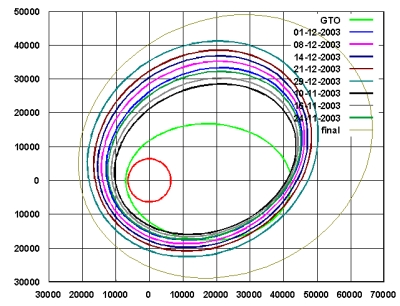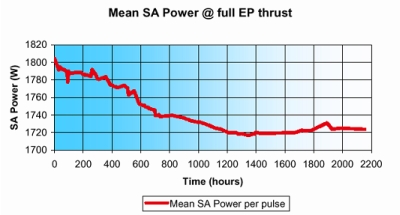No. 13 - Largest Weekly Increase in Orbit
The total cumulated thrust so far is more than 1313 hours (consuming 20.8 kg of Xenon) and has provided a velocity increment of about 930 ms-1 (equivalent to 3350 km per hour). The electric propulsion engine's performance, periodically monitored by means of the telemetry data transmitted by the spacecraft and by radio-tracking by the ground stations, continues to show a small over performance in thrust, varying from 0.9% to 1.2% over the last week.
The degradation of the electrical power produced by the solar arrays has now ceased. The power available has remained virtually constant for almost 1000 hours. The graph below displays the measured power produced by the solar arrays when the EP is operating at full power starting from the beginning of mission.
The communication, data handling and onboard software subsystems have been performing well in this period.
The thermal subsystem continues also to perform well and all the temperatures are as expected. The temperature of the star tracker optical heads has remained high, though.
Orbital/Trajectory information
The osculating orbital elements are periodically computed by the ESOC specialists. These elements define the so called "osculating orbit" which would be travelled by the spacecraft if at that instant all perturbations, including EP thrust, would cease. So it is an image of the situation at that epoch. In reality the path travelled by the spacecraft is a continuous spiral leading from one orbit to another. The most recent osculating elements are as follows:
|
EPOCH (UTC) 2003/12/29 05:21:47.8 Elements WRT Earth (J2000) |
|
| Pericentre Distance (km) |
17 235.508541 |
| Apocentre Distance (km) |
54 102.641930 |
| Semi Major Axis (km) |
35 669.075235 |
| Eccentricity |
0.516794 |
| Inclination (deg) |
6.847919 |
| Asc. Node (deg) |
151.389366 |
| Arg. of Pericentre (deg) |
210.386482 |
| True Anomaly (deg) |
179.997027 |
| Osc. Orbital Period (h) |
18.622855 |
In this diagram the osculating orbits at launch (GTO) and at different times are plotted. The large orbit, marked 'final', is the one we expect to achieve at the end of the radiation belt escape (pericentre larger than 20 000 km) likely to be reached next week. From the start, the electric propulsion system has managed to increase the semi-major axis of the orbit by 11 039 km, increasing the perigee altitude from the original 656 km to 10 857 km and the orbital period by about 8 hours, from the initial 10 hours 41 minutes to the present 18 hours and 37 minutes.
 |
Contact Point
Giuseppe Racca
SMART-1 Project Manager
ESA/ESTEC - SCI-PD
Keplerlaan 1- 2200 AG Noordwijk, The Netherlands
E-mail: Giuseppe.Racca esa.int
esa.int


